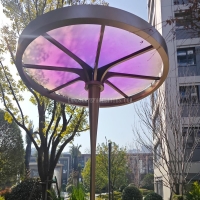Welcome to the website for landscape facilities products and knowledge.
Does acrylic fabric affect water drainage in a landscape tree box?
Acrylic fabric is increasingly used in urban landscaping, particularly in tree boxes, due to its durability and aesthetic appeal. However, its impact on water drainage remains a topic of debate. Tree boxes, designed to support healthy tree growth in urban environments, rely on efficient water drainage to prevent root rot and soil compaction.
Acrylic fabric, when used as a liner or cover, can influence drainage in two ways. First, its tightly woven structure may slow water penetration, especially if the fabric is not permeable. This could lead to water pooling on the surface, potentially suffocating roots. Second, if the fabric is treated with water-resistant coatings, it might further hinder drainage, creating an unfavorable environment for tree health.
On the other hand, some acrylic fabrics are engineered with micro-perforations to allow controlled water flow. These variants can improve drainage by preventing soil erosion while still retaining enough moisture for the tree. Proper installation is key—ensuring the fabric is layered loosely and paired with gravel or porous soil can mitigate drainage issues.
For urban planners and landscapers, choosing the right acrylic fabric is critical. Opt for breathable, permeable options and avoid dense weaves. Regularly inspect tree boxes to ensure water isn’t accumulating, and consider combining acrylic fabric with other drainage solutions like perforated pipes.
In conclusion, acrylic fabric can affect water drainage in landscape tree boxes, but its impact depends on material quality and installation methods. Selecting the right fabric and maintaining proper drainage practices will ensure healthy urban trees.
Related search:

Recommendation
Metal frame with gradient color acrylic combined with high-end shading landscape facilities